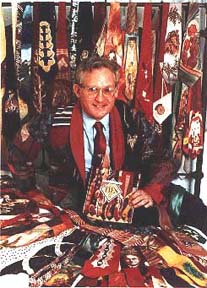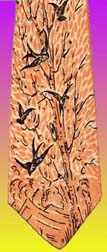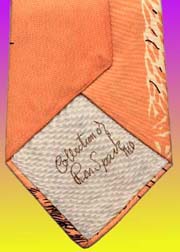![]()



Abbeyville Press American Institute for Graphic Design--Book AwardGet your copy of Ron's book here... Ron Spark's Web Site
Interested in having your copy of FIT TO BE TIED autographed?... Dr. Ron Spark has graciously offered to autograph your book if you pay postage both ways. (Would be approximately $3.85 each way if sent by U.S. Postal Priority Mail.) Dr. Spark also has additional copies of his book available autographed for $20.00 each plus shipping costs. Contact Dr. Spark at: Dr. Ron Spark P.O. Box 43877 Tucson, AZ 85733-3877

Text from article on the Any Swing Goes web site
Vintage Ties June 24, 1999 "As a kid I collected everything." Ron Spark's sentiments echo similarly with other collectors as well. "I first was going to be an art historian, and wound up going to medical school where the only thing you could wear was white. A necktie was the only expression of individuality." Spark, began doing research on the history of neckwear. "There was nothing written on the subject." He searched through Gentleman's Quarterly, Life, and Esquire magazines as well and begin a collection of ties in hopes to write about them. This led him on the path to co-author "Fit To Be Tied", a pictorial chronicle of ties of the 1940's and 1950's, now in its fifth printing, and has sold nearly 50,000 copies. Meanwhile Sparks collection has grown to 4,000 ties, with 3,000 of those being from the era of the book. Of his favorites include: Victorian ties, Polyester Commemorative Ties and his Salvador Dali ties, of which he has 43 different designs. Where Do I Find Them? There are still a lot of vintage clothing places, but those may be the higher prices. You may get lucky finding them in a thrift or second-hand store, but those finds get fewer and fewer. Flea markets are another great place to find them. It all depends how much time and effort you want to take. Also, some ties show up in antique malls. How Do You Know It Is Old? "Well it is a bit like archaelogy." Fabrics to look for include cellulose, rayon or silk-blend. One of the sure-fire tell tale signs is a width of 3 1/2 - 4 1/2 inches at the widest part of the tie. Also the variation of colors are very different from the colors today. Colors include peach, lime green, and cobalt blue and unusual color combinations like greens with pink/peach. If the tie has a tie band to tuck the tail of the tie, it is a retro or knockoff, tie bands did not really exist until the 70s. Bowties were also very popular from the 20s to the present and the way you can tie them in three dimensions with a vest is also quite popular. According to Spark, bowties tend to be undervalued. You can find vintage bowties easier because they are usually tied by hand. Clip-on bowties were not popular until the 1950's. Retro Ties If you cannot afford and/or find classic vintage ties, there is a plethora of new ties with old designs. Brands include Stringbeans, Retro, Swing, among others. Invariably there will be dead store stock, mint retro tie $30-70 for $5-10. You may even be able to find them in second-hand or thrift shops for less. Final Tips "Make friends with the older generation. I've made most of my contributions from friends, boxes in the attics and granddad's collections." Handpainted ties are another popular collectible, as well as photographic ties. Ties are a great thing to collect because you will rarely see the same tie twice and you can wear them like art.